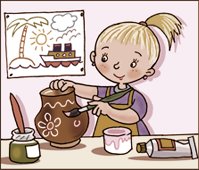Leonardo da Vinci - výtvarná výchova
| Jméno: | Zuzana Kubíková |
|---|
| Škola: | 1. ZŠ, Plzeň |
|---|
| Rok: | 2010 |
|---|
Metodické pokyny pro učitele
| Předmět: | výtvarná výchova |
|---|
| Název aktivity: | Leonardo da Vinci |
|---|
| Jazyk: | AJ |
|---|
| Jazyková úroveň: | B1 |
|---|
| Doporučený ročník: | 9.třída |
|---|
| Předpokládaná délka: | více vyučovacích hodin |
|---|
Cíle aktivity
Obsahové cíleRecognize Leonardo´s paintings and sketches among the work of the other artists
Identify areas of Leonardo work and give examples of his work (painter, inventor).
Explain how Leonardo connected these two areas in his work.
- Explain why he is considered to be genius.
- Identify three interesting points for each of these five areas: Leonardo´s perspective, Leonardo inventor, Mona Lisa, Last Supper and from sketches to painting
Jazykové cíle
Name 4 Leonardo´s paintings in English
Master following key words: (sketch, drawing, renaissance, middle age, craft, lifelike, observation, light and shade, portrait, feature, expression, mural painting, crucifixion,Holy Trinity, restoration, draftsman)
Kompetence
Kompetence k učení:žák samostatně pozoruje a experimentuje
Kompetence komunikativní: žák formuluje a vyjadřuje své myšlenky a názory v logickém sledu, vyjadřuje se výstižně, souvisle a kultivovaně
Kompetence sociální: žák přispívá k diskusi v malé skupině i k debatě celé třídy, chápe potřebu efektivně spolupracovat s druhými při řešení daného úkolu, oceňuje zkušenosti druhých lidí, respektuje různá hlediska a čerpá poučení z toho, co si druzí lidé myslí, říkají a dělají
Pomůcky
2 Power Point presentations,PC, pictures, papers, texts, worksheets, scissors, glue, markers,dictionary, camera
PřílohySoubor 1 Soubor 2
Pracovní postup aktivity
PP aktivity je součástí PPP.
1. Short introduction
2. What do you know about Leonardo da Vinci?
3. Work with pictures by Leonardo.
4. Groupwork - making a poster
5. Discussion about the posters
6. Summing up, discussion
Klíč:
Použitá literatura, zdroje: http://www.mos.org/sln/leonardo/
http://en.wikipedia.org/wiki/Main_Page
http://www.google.com/imghp?hl=en&tab=wi
Brinton, D. M., & Holten, CH. (1997). Into, through, and beyond. A framework to develop
content-based material. Retrieved October 1, 2010, from
http://exchanges.state.gov/englishteaching/forum/archives/1997/docs/97-35-4-c.pdf
Cook, V (2001) Second Language Learning and Language Teaching 3rd edition London: Arnold
Darn, S. (2006a). CLIL: A European Overview. Retrieved Septemberber 5, 2010, from
http://www.stevedarn.com/?Writings::CLIL%3A_A_European_Overview
Eurydice. (2005). Content and language integrated language at school in Europe. Eurydice,
the information network on education in Europe. Retrieved September 17, 2010 from http://www.aulaintercultural.org/IMG/pdf/CLILEN.pdf
Jones, R. (2007). Strategies for reading comprehension. K - W – L. Reading Quest.
Retrieved September 27, 2010, from http://www.readingquest.org/strat/kwl.html
Lasagabaster, D. (2008) „Foreign Language Competence in Content and Language
Integrated Courses?, [online], The opened Applied Linguistics Journal, 1, pp. 31-42.
Retreived September 17 from:
Landsberger, J. (n.d.). Reading. Study Guides and Strategies. Retrieved
September 19, 2010, from http://www.studygs.net/preread.htm
Lorenzo, F. (2008) „Instructional discourse in bilingual settings. An empirical study of
linguistic adjustments in content and language integrated learning?, [online], Language
Learning Journal, 36, (1), pp.21-33. Available from:
Moore, P., Lorenzo, F. (2007) „Adapting Authentic Materials for CLIL Classrooms: an
Empirical Study?, [online], in Vienna English Working Papers, 16 (3),
Available from: http://www.univie.ac.at/Anglistik/ang_new/online_papers/views/current.htm
Malinovska, L., & Zeidmane, A. (n.d.). CLIL cross cultural dimensions. CLIL-AXIS.
Retrieved September 20, 2010, from http://www.clilaxis.
net/new_pdfs/CLIL%20cross-cultural%20Dimensions.pdf
Prior knowledge. Excerpted from Kujawa, S., & Huske, L. (1995). The strategic teaching
and reading project guidebook (Rev. ed.). Oak Brook, IL: North Central Regional
Educational Laboratory. Retrieved October 1, 2010, from
http://www.ncrel.org/sdrs/areas/issues/students/learning/lr1pk.htm
http://clanky.rvp.cz/clanek/c/Z/8879/pojeti-clil-a-bilingvni-vyuky.html/
http://www.cat4mba.com/english-e-book/How-to-Improve-Reading-Comprehension
Pracovní postup pro žáky
| Předmět: | výtvarná výchova |
|---|
| Název aktivity: | Leonardo da Vinci |
|---|
| Jazyk: | AJ |
|---|
Instrukce žákům v cílovém jazyce:
Today we will speak about a famous painter and inventor. We will work on the basis of my PowerPoint presentation, so let's get down to business.Kraj č.19:
1. I will show you a picture of a man. "Who is the man?"
I will read some information about him. If you are not sure, I can help you a little: ("put the letters into the correct order to make the name of the man up):S O T Y P H A G R A
2. This is a right-angled triangle. Please describe it by matching the right words.
3. This is the the rule and definition of the Pythagorean Theorem. Fill in the gaps to show that you understand the terms.
4. Prove the definition. Here are 3 worksheets and you will prove the Pythagorean Theorem by cutting the exact parts of squares.
5. Now, let's play the video solution on the web.
6. Here is another proof of the Pythagorean Theorem by using water in the video.
7. Follow-up activities (or homework) - Two mathematics tasks are given to the students to solve either at school or at home.

